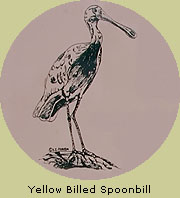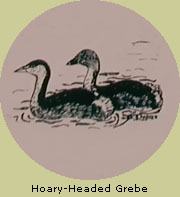|
35°42' S, 137°31' E
Here you may observe the birdlife on the Lagoon from the shelter
of the bird hide. You can investigate old relics from the past,
or just wander on the scenic walking trail which takes you along
the banks of the Lagoon and the Cygnet River.
Duck Lagoon is a fragile place and there are a few simple rules
that need to be followed.
Please do not disturb the birdlife
Swimming in the lagoon is not permitted
Dogs are not permitted
Camping is not permitted
Firearms are not permitted
Throughout Southern Australia the clearance of native vegetation,
to make way for agriculture, has led to a rise in underground
water tables. On Kangaroo Island, where an average of 300 kg of
salt falls with the rain on every hectare (1 hectare=2.47 acres)
of land each year, this process has brought the salt to the surface.
The subsequent run-off from affected areas is now damaging remnant
trees in the Cygnet River Lagoon system.
Prior to the 1960's the Lagoon had a very different appearance
to what is seen now. It was covered in Bullrushes and Water Weeds,
and was home to an abundance of Ducks, Moor Hens, Coot, Egrets
and Herons. Many of these birds used to nest in large colonies
near the Lagoon.
There were also large flocks of smaller birds, such as Finches
and Wrens. Kingfishers were common and nested in the areas around
the Lagoon.
By the early 1960's the Lagoon had become affected by increasing
salinity. This had been caused by land clearance around the Lagoon
and further upstream in the catchment areas. The number of fish
dropped drastically, and the Water Weeds and Bullrushes died out.
Waterfowl which prefers fresh water conditions became less abundant
at the Lagoon. Species that tolerate saline conditions such as
the Musk Duck, Chestnut Teal, Hoary-Headed Grebe, Spoonbills and
Swans were less affected.
In March 1993 fifteen local trainees were enrolled in a 6 months
'Youth Conservation Corps' project. Re-vegetation plots were constructed
to re-establish some of the original vegetation, to encourage
the return of birdlife.
A bird hide and observation platform were also build as part of
this project, and visitors to the Lagoon can now take advantage
of these facilities, to view the water birds.
One can see a number of dead Gumtrees in the Lagoon. This process
has occurred over a long period of time, and is linked with the
gradual increase of salinity in the Lagoon, as well as the rising
saline groundwater in the area.
In drier months of the year the water in the Lagoon becomes stagnant
and more saline as there is no water flow. During the winter months
when the water level rises, the Lagoon becomes slightly fresher.
In years of high rainfall, when flooding occurs, the Lagoon is
flushed out and the trees have a healthier appearance as a result.
Text credited to:
Kelly Parker and Sheree Whittle
(SA Youth Conservation Corps)
Illustrations credited to:
Kelly Parker
(SA Youth Conservation Corps)
|